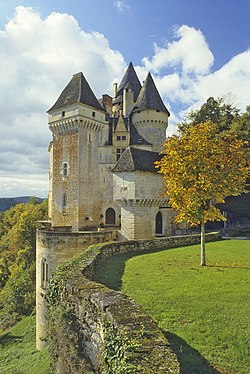This article contains promotional content. (October 2022) |
Nouvelle-Aquitaine
| |
|---|---|
 The Château de la Roque in Meyrals | |
 | |
| Country | |
| Prefecture | Bordeaux |
| Departments | 12
|
| Government | |
| • President of the Regional Council | Alain Rousset (PS) |
| Area | |
• Total | 84,036 km2 (32,446 sq mi) |
| • Rank | 1st |
| Population (2021)[1] | |
• Total | 6,069,352 |
| • Density | 72/km2 (190/sq mi) |
| Demonym | New-aquitanians |
| GDP | |
| • Total | €189.278 billion |
| • Per capita | €31,700 |
| Time zone | UTC+01:00 (CET) |
| • Summer (DST) | UTC+02:00 (CEST) |
| ISO 3166 code | FR-NAQ |
| Official languages | French |
| Website | www |
Nouvelle-Aquitaine (French pronunciation: [nuvɛl akitɛn] )[3] is the largest administrative region in France by area, spanning the west and southwest of Metropolitan France. The region was created in 2014 by the merging of Aquitaine, Limousin, and Poitou-Charentes in a territorial reform. Nouvelle-Aquitaine has an area of 84,035.7 km2 (32,446.4 sq mi) – more than 1⁄7 of Metropolitan France – and has a population of 6,033,952 as of 2020[update].[4] The new region was established on 1 January 2016, following the regional elections in December 2015.[5]
It is the largest region in France by area (including overseas regions such as French Guiana), with a territory slightly larger than that of Austria. Its prefecture and largest city, Bordeaux, together with its suburbs and satellite cities, forms the seventh-largest metropolitan area of France, with 850,000 inhabitants. The region has 25 major urban areas, among which the most important after Bordeaux are Bayonne (288,000 inhabitants), Limoges (283,000), Poitiers (255,000), Pau (241,000) and La Rochelle (206,000), as well as eleven major clusters.
New Aquitaine has five universities (Bordeaux, La Rochelle, Limoges, Poitiers and Pau) and several Grandes Écoles. It has three of the four historic resorts on the French Atlantic coast: Arcachon, Biarritz and Royan, as well as several ski resorts (most notably Gourette).
Its economy is based on agriculture and viticulture (vineyards of Bordeaux and Cognac), tourism, a powerful aerospace industry, digital economy and design, parachemical and pharmaceutical industries, financial sector (Niort) and industrial ceramics (Limoges). The new region includes major parts of Southern France ("Midi de la France"), marked by Basque, Occitan, Poitevin and Saintongeais cultures. Historically, it is the "indirect successor" to medieval Aquitaine; it extends over a large part of the former Duchy of Eleanor of Aquitaine.
- ^ "Téléchargement du fichier d'ensemble des populations légales en 2021" (in French). The National Institute of Statistics and Economic Studies. 28 December 2023.
- ^ "EU regions by GDP, Eurostat". Retrieved 18 September 2023.
- ^ Occitan: Nòva Aquitània [ˈnɔβɔ akiˈtanjɔ] or Novèla Aquitània [nuˈβɛlɔ akiˈtanjɔ]; Basque: Akitania Berria; "Akitania Berria Euskadi Nafarroa Proiektu-deialdiaren jaurtiketa" (in Basque). Educación Navarra. Nafarroako Gobernua. 27 March 2013. Retrieved 17 November 2020. Poitevin-Saintongeais: Novéle-Aguiéne; Spanish: Nueva Aquitania)
- ^ "Comparateur de territoire: Région de la Nouvelle-Aquitaine (75)". Insee. Retrieved 8 September 2020.
- ^ "La carte à 13 régions définitivement adoptée" (in French). Le Monde. Agence France-Presse. 17 December 2014. Retrieved 13 January 2015.

